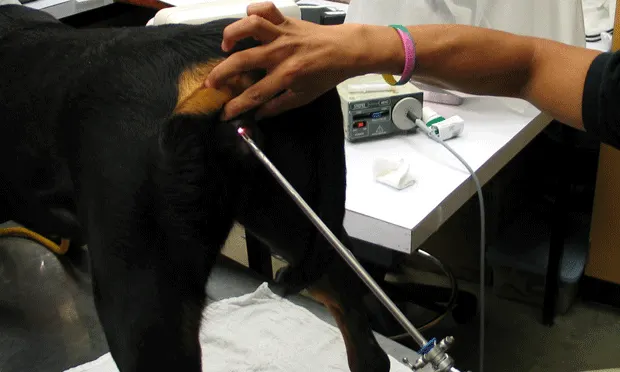Artificial Insemination in the Female Dog
Bruce E. Eilts, DVM, MS, DACT, Louisiana State University
Jose A. Len, DVM, Louisiana State University

Artificial insemination, a common procedure in small animal reproduction, is as effective as natural breeding. It can be used for breeding with fresh semen if the female dog will not stand for the male because of behavioral or anatomic problems, if the male has physical problems that prevent mounting, or the male refuses to mount the female. Of course, in some instances, a male is inaccessible and artificial insemination using cooled or frozen semen is the only alternative. The clinician should ensure that the female is in estrus before proceeding.
Step-by-Step: Artificial Insemination
What You Will Need
Fresh, chilled, or frozen semen
Small animal insemination pipette
Syringe without rubber plunger
If using frozen semen, you will also need:
Rigid 30-cm cystourethroscope with a 30° viewing angle and light source
8-Fr polypropylene urinary catheter
Preparation
Step 1
The first step is to ensure the dog is in estrus. Identifying estrus can be done using vaginal cytology for a fresh semen breeding, and combining hormone analysis (progesterone and/or luteinizing hormone) when using chilled or frozen semen to identify the most fertile days to breed.
Step 2
A complete semen analysis, including motility, volume, concentration, and morphology, should be performed on fresh or chilled semen, and the motility of frozen semen should be assessed before insemination. A semen analysis before breeding will help answer questions later if the female dog fails to become pregnant.
Frozen semen should be thawed according to the instructions provided by the freezing facility, and it should be used immediately upon thawing. (That is, it should be thawed only when the catheter is within the uterus.)
Vaginal Approach
Step 1
Once estrus is confirmed or the most fertile days have been determined and the semen sample is ready, artificial insemination can be performed. Large dogs can be restrained gently on the floor (smaller dogs can be placed on a table), the tail moved aside, and the dorsal commissure of the vulva lifted by placing the fingers above the vulva and lifting.

Step 2
A small animal insemination pipette is then placed in the dorsal commissure of the vulva (A) and directed dorsally and almost caudally to create a ‘dimple' between the dorsal commissure of the vulva and anus (B). The dorsal placement of the pipette helps prevent entry into the urethra (C). The pipette is then redirected cranially into the cranial vagina (D); however, for the transcervical approach (page 15) the cervix normally cannot be entered using this technique. If the pipette will not advance, it may be caught on one of the many vaginal folds and it should be withdrawn slightly and redirected past the fold. The syringe can be placed on the pipette either before elevating the hindquarters or after (E).
Procedure Pearl
If the pipette will not advance, it may be caught on one of the many vaginal folds and it should be withdrawn slightly and redirected past the fold.



Step 3
The dog can then be lifted by the hocks and the semen pushed through the pipette with a small amount of air following it to ensure emptying. After insemination, the dog can be lowered. There is no need to elevate the hindquarters after artificial insemination, as in a study conducted by the author, pregnancy rates and fecundity were not different if the hindquarters were elevated for 0, 1, or 10 minutes.1
Procedure Pearl
After insemination, a small amount of air should be pushed through the pipette to ensure that it is completely empty.

Transcervical Approach
If frozen semen is used, or direct placement of the semen into the uterus is desired to increase the chance of pregnancy with fresh or chilled semen, then a transcervical approach can be used. Transcervical insemination is technically more challenging and requires specialized equipment, but is routine in some reproductive practices using a rigid cystourethroscope.
Step 1
The initial approach of placing the transcervical scope into the vagina is the same as for routine artificial insemination.

Step 2
However, once the transcervical scope is within the cranial vagina (A), the cervix is visualized (B) and a smaller polypropylene catheter is passed through the cervix into the uterus.
Procedure Pearl
The transcervical approach can be used for frozen semen or if direct placement of semen into uterus is desired.

